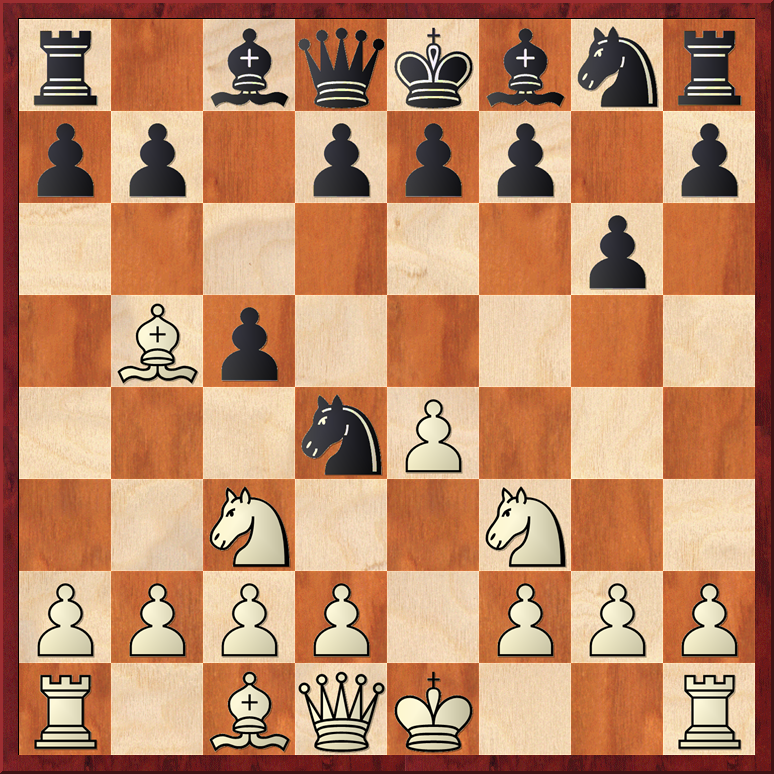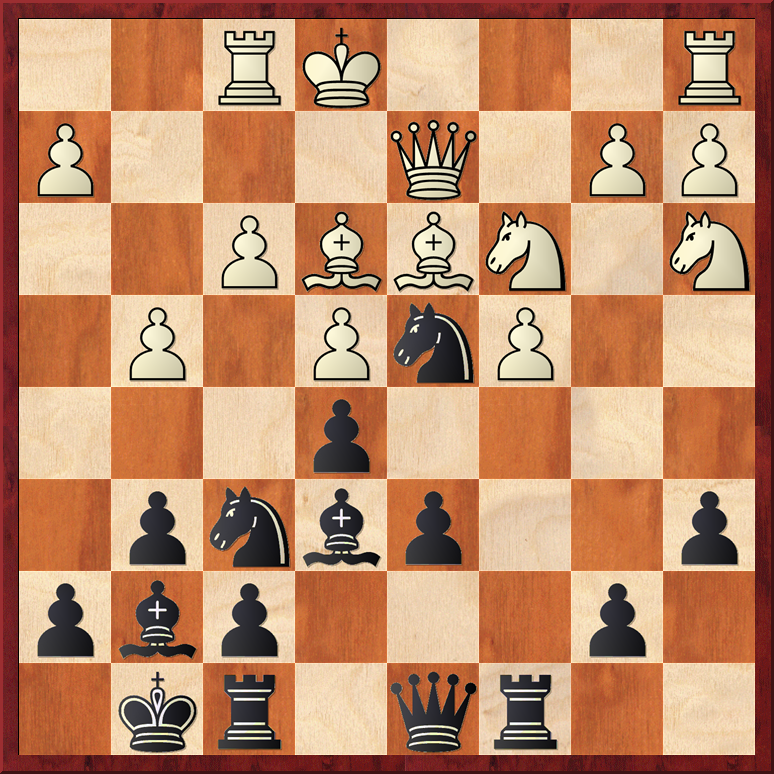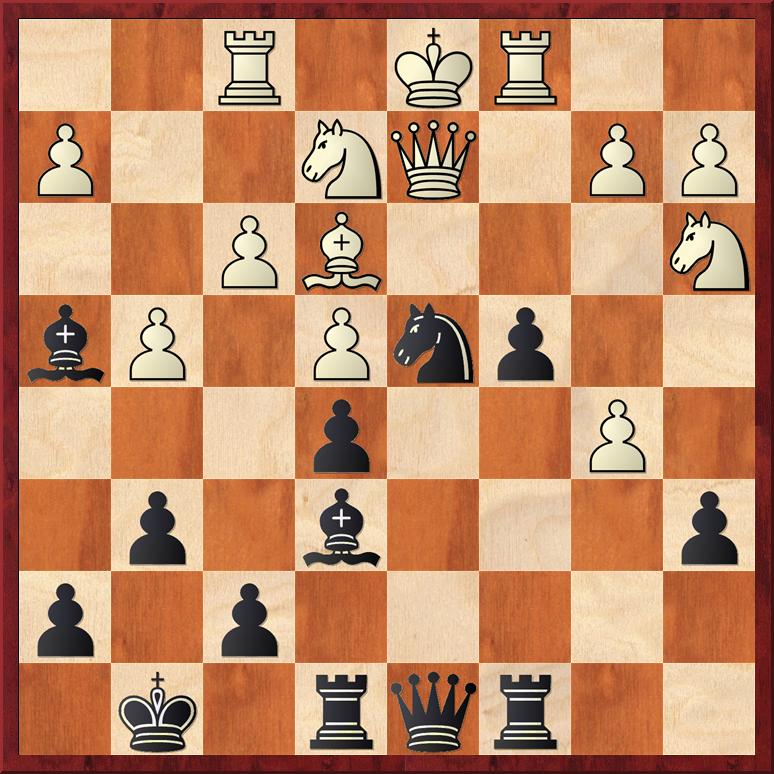The US Amateur Team East was held over three days from February 18-20, 2023 in Parsippany, NJ. I usually try to make it each year; in the past I have played some remarkably crazy games at this event.
My first two games were pretty easy wins against lower rated players. Let's see what we can learn from them before moving on to the next two rounds.
Paciorkowski, Lev (2422) - Wang, Yuan (2066)
US Amateur Team East, Parsippany, NJ (Rd. 1)
40/100 SD 30 d5
1.e4 I had actually found my opponent's chess.com account a few minutes before the game started, and I saw that he played the Sicilian and might not know what to do against the Nc3-Bb5 line, hence my unusual (for me) opening choice. 1. ... c5 2.Nc3 Nc6 3.Bb5 Nd4 4.Nf3 g6?! (D)
As we have already seen in my game against William Graif, this move is already inaccurate for black! I made the same mistake myself and fortunately my opponent did not properly take advantage. Here I had learned from my own mistake to now be able to play the most testing continuation for white. I think black should instead play 4. ... a6!, which equalizes as far as I can tell.
5.Bc4! It's a crude move - white just wants to attack f7 with Qf3 in a couple moves, but because black is underdeveloped it turns out he will have to make some concession to stop mate. 5. ... Bg7 6.Nxd4 cxd4 7.Qf3 (D) Here my opponent had a long think.
Although this is already suboptimal for black, it is still playable. After some post-game analysis, I think black's best bet is 7. ... Nf6 8.e5 (white's point) dxc3 9.dxc3! (stronger than taking on f6 straightaway) and now very importantly 9. ... Qb6! (9. ... 0-0? 10.exf6 Bxf6 11.Bh6 Bg7 12.Bxg7 Kxg7 13.0-0-0 +/- is great for white) 10.exf6 Qxf6 11.Qe2 0-0 12.Be3 d6 13.h4 h5 and black is close to equality here.
The devious trap that I very well could have fallen into is 7. ... e6 8.Nb5 d6? 9.Qa3! when white is already nearly winning. This line is actually somewhat playable for black if he instead sacrifices a pawn with 8. ... d5! 9.exd5 a6 10.dxe6 fxe6 11.Na3 Nf6 when there is definitely compensation, although it shouldn't quite be enough for a full pawn.
Instead, my opponent played 7. ... Nh6, but now white has an easy advantage because this knight is horribly placed here. 8.Ne2 0-0 9.d3 Hinting at taking on h6 and then on d4. 9. ... Qb6 (D)
Here's an instructive moment. I played my next move without really thinking all that much, but I didn't properly appreciate how big white's advantage is just by playing slowly and trying to round up the d4 pawn. Consider this: 10.h3 Kh8 (black has to try and get the knight back into play) 11.0-0 d6 12.Qg3 Ng8 13.a4 a5 14.f4 e6 15.Qf2! Ne7 16.b3 Bd7 17.Bb2 Nc6 18.Bb5! and black is hard pressed to avoid losing material.
Instead, I played the tempting 10.h4!? black has a strong defensive counter which we both overlooked. 10. ... d6? The only way to stay in the game was 10. ... Ng4!, which we both missed. The point of course is 11.Qxg4 d5, and on 11.h5 Ne5 black eliminates the important light squared bishop and should be doing OK, although the position is still messy. After my opponent's move, white just has a decisive attacking position.
11.h5 Ng4 12.hxg6 hxg6 13.Bb3 a5 14.a4 Bd7 15.Qg3 Qc5 There's really no way to hold the kingside together - I just have too many pieces pointing in that direction. 16.Nf4 The g6 pawn is indefensible. 16. ... Nf6 17.Nxg6 Rfe8 (D)
Of course any move should win here. I finished the game in style: 18.Nh8 Kf8 19.Nxf7 d5 20.Ne5 1-0
Let's have a look at round 2.
Abdi, Farzad (2261) - Paciorkowski, Lev (2422)
US Amateur Team East, Parsippany, NJ (Rd. 2)
40/100 SD 30 d5
Here my opponent is a slightly higher rated player around master level. 1.e4 c5 2.Nf3 Nc6 3.d4 cxd4 4.Nxd4 e5 Lately I've been experimenting around with the Kalashnikov Sicilian... 5.Nb5 d6 6.c4 Be6 (D) We are following a trendy line that has recently become popular for black. Traditionally, black would play ...Be7 and go for f7-f5 later.
The main line is now 7.N1c3, when we reach an important tabiya position after 7. ... a6 8.Na3 g6 (the trendy way to develop, instead of ...Be7) 9.Nc2 Bg7 10.Be3 Nf6 11.Be2 0-0 12.0-0 Rc8 - this would be a good position to analyze in depth at some point...
Instead, my opponent decided to quickly leave charted waters and play his own way. 7.Bd3!? I don't know if this is really a better square than e2 since it does block the queen and the bishop is hardly doing anything on the b1-h7 diagonal. 7. ... g6 8.N1c3 a6 9.Na3 Bg7 10.Be3 Nf6 11.f3 Having the bishop on e2 would also have covered the important g4 square. 11. ... 0-0 12.Qd2 Rc8 (D)
I actually could have already played 12. ... b5!? 13.cxb5 axb5 14.Naxb5 d5, but in the end it liquidates to dry equality after 15.exd5 Nxd5 16.Nxd5 Bxd5 17.0-0 Rxa2=. So I like my move better, keeping the tension.
Now of course white should just castle (kingside) here, but instead he decided now was a good time to go crazy. 13.g4? This is a really bad move. White has no attack, and is just voluntarily weakening the kingside which is the only safe place for his king to go to (castling queenside is suicidal with b7-b5 lurking). 13. ... Nd4 14.Rf1? (D) This was white's last chance to castle kingside, which would at least contain the damage and keep the king safe. I think black just has a near-decisive advantage now because of the long-term weakness of white's king.
However, it is always good to be accurate about how to proceed for black! Of course my first thought was to just go for the kill right away with 14. ... b5!? 15.cxb5 d5 - this is still good for black, but it gets a little messy after 16.g5 Nh5 17.bxa6. The great thing about my position though is that I am in no rush - white has no long-term solution for the king on e1. So I played what actually turns out to be the best move: 14. ... Nd7 Now this knight can swing around to c5 or b6, and I open the diagonal to h4 for my queen. 15.Bg5 Bf6 16.Bh6 Bh4+ 17.Kd1 A sad necessity. 17. ... Re8 threatening g6-g5 when the Bh6 is suddenly trapped. 18.Be3 (D)
Now I correctly decided to follow my gut and go directly for the throat here: 18. ... b5! 19.cxb5 Nb6 (D)
White cannot prevent d6-d5, when the d-file opens up and white's king will get smoked. 20.Ne2 d5 21.Rc1 Nc4 at this point almost anything is winning for black. 22.Bxc4 dxc4 (D)
Now white has to watch out for sacrifices on f3. For example, 23.Nc2 Nxf3! 24.Rxf3 Re7! is simply crushing. Also lights out is 23.Nc3 Re7! with Rd7 next.
23.bxa6 I almost couldn't believe the audacity of this move, but it is actually the engine's top choice. White is completely lost no matter what, so I suppose as the saying goes, might as well die with a full stomach...
23. ... Re7 24.Nxd4 exd4 25.Bg5 c3! (D)
The d-file opens up and white's position collapses. 26.bxc3 dxc3 27.Rxc3 Bxg5 28.Rxc8 Qxc8 29.Qxg5 Rd7+ 30.Ke2 Qxa6+ winning a piece. 31.Qb5 Qxa3 32.Qb8+ Kg7 33.Qe5+ f6 0-1 After 34.Qxe6 I have mate in two starting with 34. ... Qb2+.
I thought we were going to have a normal game, but I could not believe my eyes at all when 13.g4? and 14.Rf1 appeared on the board. I punished this with proper force by breaking out with 18. ... b5, 19. ... Nb6 and 20. ... d5.
So far I am on 2/2, and my team overall also won these first two matches. We'll come back next time to look at games 3 and 4.











No comments:
Post a Comment